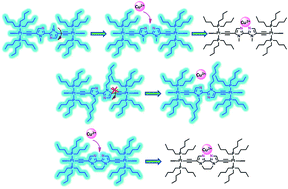Synthesis of 2,2′-biimidazole-based platinum(ii) polymetallaynes and tuning their fluorescent response behaviors to Cu2+ ions through optimizing the configuration of the organic spacers and steric effect†
Abstract
Under controlled conditions, platinum(II) polymetallaynes with different 2,2′-biimidazole-based organic spacers have been synthesized readily. Their photophysical properties and fluorescent response behaviors to Cu2+ ions have been investigated in detail. By adjusting both the configuration of the 2,2′-biimidazole-based spacers and the steric effect, the fluorescent response behaviors of the polymetallaynes to Cu2+ ions can be tuned dramatically. The fluorescent signal from the polymetallayne with an optimized structure can be quenched rapidly by Cu2+ ions with a high Stern–Volmer constant KSV of ca. 6.8 × 104 M−1 and a low detecting limit (DL) of ca. 0.99 ppm. These results not only highlight the great potential of these polymetallaynes as novel Cu2+ sensors, but also provide new strategies for optimizing the sensing abilities of the 2,2′-biimidazole-based ion sensors.


 Please wait while we load your content...
Please wait while we load your content...